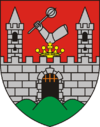Csesznek
| Csesznek | ||
|---|---|---|
 |
||
|
||
| Location of Csesznek | ||
| Coordinates: 47°21′19″N 17°52′53″E / 47.35537°N 17.88145°ECoordinates: 47°21′19″N 17°52′53″E / 47.35537°N 17.88145°E | ||
| Country |
|
|
| County | Veszprém | |
| Area | ||
| • Total | 24.20 km2 (9.34 sq mi) | |
| Population (2014) | ||
| • Total | 564 | |
| • Density | 21.61/km2 (56.0/sq mi) | |
| Time zone | CET (UTC+1) | |
| • Summer (DST) | CEST (UTC+2) | |
| Postal code | 8419 | |
| Area code(s) | 88 | |
Csesznek (German: Zeßnegg, Croatian: Česneg, Slovak: Česnek) is a village in Zirc District, Veszprém county, Hungary. The village is famous for its medieval castle.
The medieval castle of Csesznek was built around 1263 by the Jakab Cseszneky who was the swordbearer of the King Béla IV. He and his descendants have been named after the castle Cseszneky.
Between 1326 and 1392 it was a royal castle, when King Sigismund offered it to the House of Garai in lieu of the Macsó Banate.
In 1482 the male line of the Garai family died out, and King Matthias Corvinus donated the castle to the Szapolyai family. In 1527, Baron Bálint Török became its owner.
During the 16th century the Csábi, Szelestey and Wathay families were in possession of Csesznek. In 1561, Lőrinc Wathay repulsed successfully the siege of the Ottomans. However, in 1594 the castle was occupied by Turkish troops, but in 1598 the Hungarians recaptured it.
In 1635, Dániel Esterházy bought the castle and village and from that time on Csesznek was the property of the Esterházy family until 1945.
...
Wikipedia


